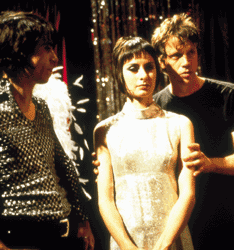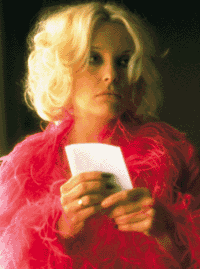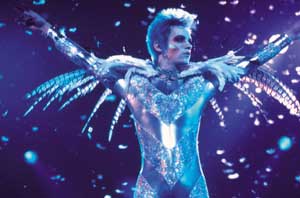FLAMING CREATURES
Few current ’70s revival films recall that period as flamboyantly or poignantly as Todd Haynes’ glam epic Velvet Goldmine. John Cameron Mitchell talks with Haynes about creative impulses, Hollywood musicals, and their first time with Bowie.
Jonathan Rhys Meyers. Photos: Peter Mountain.
Emotion – dissected, dramatized, suppressed and expressed – is at the heart of Todd Haynes’ films. Often thought of as a "cool" filmmaker, Haynes actually dramatizes in all of his films the ways in which our thoughts and feelings are constructed by the cultures we live in. Works like Superstar, Dottie Gets Spanked, Poison, and Safe form precise social critiques but they also construct characters – like Superstar’s Karen Carpenter and Safe’s Laura White – that are contemporary archetypes but tremendously affecting nevertheless.
In Haynes’ stunning new film, Velvet Goldmine, the world of glam rock, with all of its wild costumes, ornately composed music, and sexual fluidity, is recreated with loving care. Employing a Citizen Kane-like structure to the tale of a Bowie-esque rocker, Brian Slade, who fakes his death amidst personal crisis, the film references glam-relevant films like Performance and The Man Who Fell to Earth while, like the ’60s works of Alain Resnais, using memory and desire to advance a complex narrative. Boldly riffing on the past lives of a string of famous musicians – Bowie, Lou Reed, Iggy Pop – the film’s heart lies not in its exploration of rock star decadence but rather in the dreams of an outsider fan, subtly played by Christian Bale, whose own journey lies in unravelling the meanings these cultural icons are creating for him. Employing this fan’s perspective in complex ways – the film often advances its narrative solely through specific and canny period music selections – Velvet Goldmine, which, by the way, has nothing to do with music videos, contrary to some Cannes critics’ beliefs, throws us back to the oversized passions of American movie musicals while also exploring how pop music machinery can create liberating, powerful dreams within all of us.
We asked John Cameron Mitchell, the creator of Off-Broadway’s Hedwig and the Angry Inch, which also draws its inspiration from glam rock, to discuss glam, artmaking, and concert-shooting on the eve of his own movie deal with Jersey Shore. – S.M.
John Cameron Mitchell: You’re an inspiration for so many people in film because, and I can’t think of anyone else who is doing it right now, you’re willing to learn new languages to tell different stories. Some of my favorite directors have done that, like Sydney Lumet. Dog Day Afternoon and Network were made within a few years of each other.
 |
| Todd Haynes (right) directs a scene from Velvet Goldmine |
Mitchell: So many artists are suspicious of trying to change their style. Like, why aren’t you doing a Rauschenberg, Mr. Rauschenberg? What was the first moment in which you thought that filmmaking was what you wanted to do?
Haynes: I’m not sure if there was a singular event. It’s always been a bit of a struggle between intellectual reasons and a much more more instinctive, direct, physical creative need. Being a filmmaker, that need may never get directly satisfied, because of the way that a film gets made. [Making a film involves] such a distended amount of work – taking apart the idea into pieces, producing and materializing each piece, and then trying desperately to piece it back together to something close to what the original instinct was. I don’t really think one should make films to satisfy a blind need to be creative.
Mitchell: No?
Haynes: No. Or one shouldn’t make narrative films for that reason. Because when you don’t think about what you are doing, for the most part you replicate all the worst conventions that exist.
Mitchell: It becomes therapy.
Haynes: Yeah. I came to understand the distinction when I was painting. There was a certain style of painting I would do that was based on getting stoned, playing loud rock and roll, and just having an amazingly intuitive relationship to the work. It would be the most physically draining and satisfying experience. The work though, would end up being not as raw as one would like it to be.
Mitchell: Like, I’m so rock and roll, but...
Haynes: But I’m making choices about this line and this splotch of color. My painting then became more self reflexive, more "deconstructive." I would start with issues that I wanted to deal with; often it was about almost taking on representation in a semi-antagonistic or investigatory way. A lot of feminist ideas or questions were played out against images of women. And I’d use materials like lace, velvet and silk and muck them up. The paintings would be investigations into femininity or masculinity. And I think that’s what my filmmaking ultimately became.
Mitchell: Did you ever take those conceptual ideas and apply them to a more "rock and roll," intuitive process?
Haynes: The making of these paintings could still be pleasurable, but the process was much more workmanlike. It was like, I have a blueprint, a concept, an idea. And though the final result might differ slightly from the image in my head, the act of making it wasn’t a "tripped out, creative freedom" kind of thing. It was more about "working it out," much like the way I make my films. There are two different modes. Look at Safe and Superstar.
Mitchell: The "women’s" films.
Haynes: In a way. Films like Superstar and Safe were more conceptually conceived, and the process of making them was a process of learning how ideas that seemed external to me were actually internal for a lot of personal reasons. Like anorexia in Superstar – the kind of behavior it produced was something I identified with even though I’m not an anorexic, but it took making the film to figure out why I identified with it. Whereas Poison and Velvet Goldmine are films that come out of a less intellectual, more emotional connection to material that pre-exists, like Genet and glam rock. The process of making these films was a way to start distinguishing myself from this material as opposed to finding myself within it. And in a way these films are gayer, a little messier – sort of trippy movies. In some ways I think Safe and Superstar, which are cleaner and more formal, may be better films.
Mitchell: You said in an interview in Index magazine that you feel at times you’re an over-cognitive artist – and that in Velvet Goldmine, you were trying to draw out the emotional side of your storytelling.
Haynes: The emotional side of Velvet Goldmine is very elusive, because in many ways the entire project was an attempt to avoid traditional ways of communicating depth and character psychology – much in the same way that the American movie musical or the melodrama goes for a hyperbolized notion of emotion and depth. In Velvet Goldmine, the emotion is often communicated in the music. In the plot of a musical, what happens between the characters is often a bit extreme, almost operatic. It’s never about real life in a gritty way. Identification of characters just isn’t done in the same, classic Aristotelian manner of most dramas. I was trying to communicate in this film in broader, more stylized terms. The characters are in a way little distillations of real-life people and the stories that these real-life people wove around themselves in their stage personas. The biographies of David Bowie and Oscar Wilde blended together.
Mitchell: I know you’re quite the "edit-in-the-head" guy. Did you know how all the sequences in the film would cut together before shooting, or did you find it in the editing?
Haynes: No. It had to be pretty nailed down.
Mitchell: Even in those major cross-cutting musical sequences?
 |
| Toni Collette |
Mitchell: How did you shoot the concert scenes in the movie?
Haynes: It was a matter of just setting up three cameras, two 35mm, one 16mm.
Mitchell: Like shooting an explosion.
Haynes: Exactly, like shooting a stunt. And often stunts were included in those scenes, like the flame thing. Those were the scariest things to shoot because I’ve never done that before. I’ve only made films on minimal budgets where I’ve approached the lack of money by being absolutely prepared, planned out, storyboarded. I thought that I was never going to get close to being spontaneous with the camera. But with a live performance, you have to be prepared so you can catch the moment. There would be two cameras, one with a track in the audience, often laterally, with heads passing, and then sometimes a track along the side of the stage to get some movement that way. And those two cameras could avoid being in each other’s proximity with those two angles. We never did a complete take of a whole song. We would break each song down into verses and change camera angles accordingly. But it was amazing how when morale was low and Christine [Vachon, the producer] was going nuts and Maryse [Alberti, the d.p.] was freaking out and everyone was thinking we’d never finish in time, we’d say "Action" and there would be this amazing song banging through the speakers of the Brixton Academy, and everyone would perk up. It was those moments that really got us through.
Mitchell: How did you connect with glam rock in the first place? For me, it started because I was in Scotland in 1973 in boarding school.
Haynes: You actually lived it in a way I never did.
Mitchell: I was a little sissy boy in a Catholic boys-school world, and not even pubescent enough to enjoy that it was a boys school.
Haynes: Only straight boys enjoy homosexual sex in boarding schools!
Mitchell: Music was not allowed. I was in charge of the library, and there was a little record player. This was like ’73, ’74. Bowie was still a scary figure – he scared the shit out of me on Top of the Pops.
Haynes: Me too, me too!
Mitchell: I was more into Wizard, Slade and Sweet. I smuggled in Fox on the Run and played it on the headphones on the tiny library stereo. Blasted it. Danced around in the library, locked the door, knocked over all these books about the lives of saints. That record totally saved my ass at that moment. So how did you come across glam since it never really became a big thing in America?
Haynes: You and me both got to it through surrogates, semi-spokespeople. For you, the most interesting was Sweet. For me it was Elton John, Goodbye Yellow Brick Road, which I loved when I was in junior high. I loved "Benny and the Jets," which I didn’t know was a kind of artificial Ziggy Stardust.
Mitchell: So when did you get into Bowie and the glam rock bands in Velvet Goldmine?
Haynes: I remember seeing the face of Bowie in the record store on the cover of Aladdin Sane, and being completely haunted and disturbed by it. I thought it was going to be really hard acid rock that I wouldn’t be able to handle. I remember Alice Cooper and Bowie as sort of really extreme and horrific but also sexually provocative. I put it in my mind that I’d get back to this later. I couldn’t handle it then – it was just too disturbing.
Mitchell: I felt that way about be-bop. It’s fascinating, but for later – when I’m old and black.
Haynes: And then in seventh grade drama class we did lip-syncs. I was thirteen, so that was ’74. One girl did "Changes," and dressed up just like Bowie with the lightning bolt across her face and a skin tight tunic. She actually looked really pretty and like him. I thought, oh, this is Bowie, I could get into this. This isn’t so bad.
Mitchell: I just went back and listened to the first Roxy Music album, and I was just blown away. Unbelievable.
Haynes: I think it’s my favorite album, period.
Mitchell: I didn’t realize, it’s a mini-cinematic epic on disk.
Haynes: Complete melodrama.
Mitchell: Why didn’t it work in America?
Haynes: I think it’s that there is an intense investment in notions of authenticity here.
Mitchell: British culture glorifies artifice.
Haynes: Yeah. There’s a great emphasis on surface, on self-presentation, in style, in the pose, that’s all very complex. As soon as you say those words in America, it seems to be an invasion of something underneath the surface. But I think, if you read Oscar Wilde, that notions of depth are just as constructed and prescribed. This refusal to look at the surface of things is a very American thing. Music has always been defined here by the R & B tradition.
Mitchell: It’s about getting real.
Haynes: Being truthful and playing raw on stage. And the age-old critique of Americans as being irony-less –
Mitchell: – is pretty true.
Haynes: I think there’s some truth to it. I think what you see now in America is cynicism.
Mitchell: Dumb cynicism.
Haynes: Dumb cynicism, but also real cynicism that came out of things like Watergate, and the covers being blown off things in the twentieth century.
Mitchell: Doesn’t that cynicism open the door for irony?
Haynes: I guess you’re right. I find it uncomplicated, the cynicism I see – particularly in big Hollywood films. Now there’s a kind of sarcastic knowingness about genre. It’s all about conventions that are flip-flopped around – it’s not about ideas.I guess what’s at stake is emotional investment, or political investment, or investment in any kind of ideas. And that may be a question for this British tradition as well. If it’s all ironic, what do you believe in? But I think with Oscar Wilde, Roxy Music, Bowie and the more sophisticated strain of this dandy tradition, there’s a great deal at stake. It’s about questioning dominant ideas about masculinity, identity, art and the whole ability to communicate something from the gut with no mediation whatsoever.
VOD CALENDAR


 See the VOD Calendar →
See the VOD Calendar →



